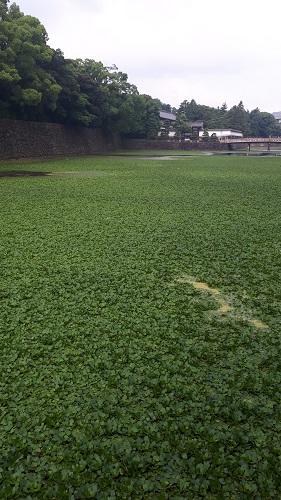Hot days continue every day. Sometimes I compare the world's highest temperature with Japanese ones, for example, Manila, Philippines.
When we know that today's minimum temperature is 25 degrees and the maximum is 30 degrees, "O ... cooler than Japan." Someday the southern country is likely to become a summer resort.

Even so, for me who is busy with heat metabolism, I jog in Tokyo, which has become a free sauna. You can run 30 km in winter, but at this time it is 10 km and hello.
Rather than sweating, the feeling that the body is melting is enough to enjoy the process of degenerating from mammal to amphibians.
The photo is not Amazon. It's a place in Tokyo.
In fact, it is the moat of the Imperial Palace. Due to eutrophication and high temperatures, the overgrowth of aquatic plants may be gaining momentum and leaving Japan.
(It is said that the moat of the Imperial Palace is also refrigerated and filtered appropriately, but the transparency differs between the Hanzomon side and the Ote-mon gate side depending on the location of the filtration device.)
Well, what to hide, I love animals, and aquatic animals have been really familiar since childhood. In the future, I was seriously worried whether to aim for the master of Kungfu or the director of the zoo.![]()
Events and history that are full of Edo atmosphere around the Sumida River are endless, and it is natural to call itself "Mizuto Tokyo" even from the daimyo residence made by drawing water from Tamagawajosui and the cityscape of Edo. I can't enter. At the Tokyo Olympics and Paralympics 2020, the importance of transportation using waterways from Haneda Airport etc. will increase more than ever.
Oh! For that reason, although it has become better than the old days when the bad smell occurred, when traveling on a boat, I am inevitably worried about "dirty water". (Of course, there may be opinions about the large population and the large number of artifacts.)
And if you would like to see the materials that summarize the current situation of aquatic animals in Chuo-ku here, we will introduce Chuo-ku "creatures in the river".
In brackish waters where salt water is mixed, river water is divided into upper, seawater is divided into lower, and when the tide rises, seawater goes up the bottom of the river to upstream. It seems that seawater flows into the Iwabuchi sluice gate in Kita Ward on the Sumida River. Speaking of Iwabuchi sluice gate, it is 20 km north of Arakawa cycling road. The brackish water continues from the mouth of the river.
In general, brackish waters are mixed with freshwater and sea creatures, so the diversity of living things increases, but from that point of view, it is a bit disappointing that there are few creatures that can be captured. (Although there is no description on the above page, you can sometimes see mokuzu crab, which is said to be delicious because of the closeness of Shanghai crab.)
We believe that the purification of water quality and the improvement of biodiversity that can be seen will increase the value of Tokyo, and we will continue to watch it. (I would like to be involved not only in looking at it, but also in efforts to clean water.)

